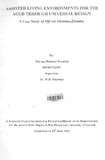| dc.description.abstract | ‘‘In an age in which efficiency and immediate gains or profit are emphasized, there lies the possibility of reducing the worth of the individual to his or her ability to contribute materially to society as opposed to seeing the intrinsic value of each as a human being regardless of age or ability. This may greatly affect more vulnerable individuals in society including the elderly, disabled and those declining in health. ” Martha Tyson
This research investigates on design for the aged. As we know, the ageing process brings into play some factors that can potentially restrict one’s life. As a result of the diverse needs of the aged, the environment they live in must be well suited to support them. Design can aptly be used to adapt these environments. Victor Reigner calls this type of design for special groups “assisted living”. (Reigner, Pg 1). Universal Design is recommended for creating these assisted living environments. This is because it is an approach to the design of all products and environments to be used by everyone regardless of age, ability or situation. In addition, Therapeutic Design is also a relevant tool since it is the design of an environment that supports health and well being. (Tyson, pg 4)
Mji wa Huruma, Home for the Aged that is located in Kiambu was used as a case study. Using qualitative data collection tools like focus groups, guided interviews and questionnaires, the researcher investigated the current facilities at the home and their conditions. In addition, the researcher profiled the residents citing their lifestyles, medical conditions and their other special needs. The data analysis done established that Mji wa Huruma had not adequately applied universal and therapeutic design. In addition, Nyumba ya Wazee, a home for the aged located Kasarani was used as a comparative case study. This is because, investigative research carried out at the site established that both universal and therapeutic design had been applied so as to create an assisted living environment.
The data analysed by the researcher has been presented in form of detailed reports, tables, charts and photographs. In conclusion, the researcher has recommended applicable design solutions using universal and therapeutic design for the interior architecture, furniture design, landscaping, exhibition and display at Mji was Huruma. | en_US |



